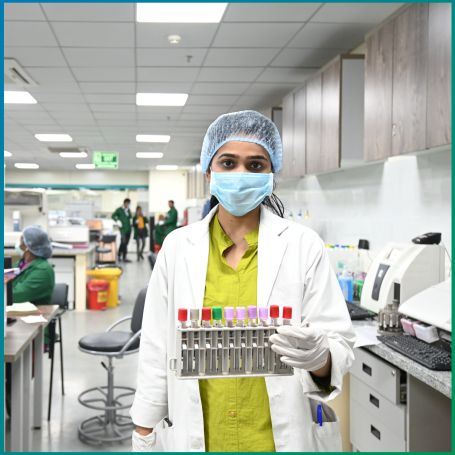
The Gram stain test is a laboratory procedure used to differentiate bacterial species into two main groups: Gram-positive and Gram-negative bacteria.

This classification is based on the structure of the bacterial cell walls and their ability to retain certain dyes during the staining process.
1] Gram-positive bacteria have thick peptidoglycan layers in their cell walls, which allows them to retain the crystal violet stain, appearing purple under a microscope.
2] Gram-negative bacteria have thinner peptidoglycan layers and an outer membrane, causing them to lose the crystal violet stain but retain the counterstain (safranin), appearing pink or red.
The gram staining process involves several steps that must be carefully followed to ensure accurate results:
1] Sample Preparation: A small sample (usually from a swab, sputum, or bodily fluid) is spread thinly on a glass slide and then fixed by heating.
2] Application of Crystal Violet: The slide is stained with crystal violet, a purple dye that initially stains all the bacteria present on the slide.
3] Iodine Treatment: Iodine is then added, which acts as a mordant, forming a complex with crystal violet, helping to fix the dye to the bacterial cell wall.
4] Decolorization: The slide is rinsed with alcohol or acetone, which decolorizes Gram-negative bacteria while leaving Gram-positive bacteria stained.
5] Counterstaining: A counterstain, usually safranin, is applied, which stains the decolorized Gram-negative bacteria pink or red, while Gram-positive bacteria remain purple.
Once the staining is completed, the gram stain results are examined under a microscope to identify whether the bacteria are Gram-positive or Gram-negative, as well as their shape (cocci, bacilli, etc.).
1] Gram-Positive Results: If the bacteria appear purple under the microscope, they are considered Gram-positive. Examples include Staphylococcus and Streptococcus species, which are commonly associated with infections like strep throat or skin infections.
2] Gram-Negative Results: If the bacteria appear pink or red, they are categorized as Gram-negative. Examples include Escherichia coli (E. coli) and Pseudomonas aeruginosa.
Diagnopein Diagnostic Centre in Pune offer comprehensive, accurate, and timely diagnostic services, including the Gram Stain test Pune. With our NABL-accredited labs, cutting-edge technology, and skilled technicians, you can be assured of reliable results every time. Get your results quickly, especially when time is crucial in detecting severe infections.
Competitive pricing without compromising on quality. Our team of experienced professionals ensures the test is conducted smoothly with minimal discomfort. We provide not just the Gram Stain test results but insights into your health condition, helping you and your doctor make informed decisions about treatment. For more information call us at +91 9204 108108.
1. Sample type
2. Gram Stain
3. Pus Cells
4. Epithelial Cells
No special preparation is required for the Gram Stain Test. However, your healthcare provider may give specific instructions depending on the sample type (urine, sputum, etc.).
Yes, the Gram Stain Test can be done for children, and it is a useful diagnostic tool for identifying bacterial infections in pediatric patients as well.
There are no significant risks involved in the Gram Stain Test. It is a simple procedure involving sample collection, such as blood, sputum, or a swab from the infected area.
The Gram Stain blood Test is crucial because it helps identify the type of bacteria causing an infection. This information guides doctors in selecting the most effective antibiotic for treatment.